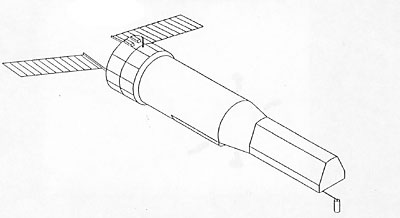The invisible Big Bird: why there is no KH-9 spy satellite in the Smithsonian<< page 1: emerging from the shadows A break in the shadows?In August 2002 the National Imagery and Mapping Agency suddenly announced plans to hold a conference on newly declassified satellite imagery. NIMA, which is now called the National Geospatial-Intelligence Agency (NGA), was the successor to the agencies that had long studied the photographs from spy satellites during the Cold War. NIMA’s announcement was unexpected and rushed, with the conference held only a month later in September. At the conference, NIMA officials showed off imagery from the KH-7 GAMBIT and the low -resolution mapping camera on the KH-9 HEXAGON. But neither the names GAMBIT or HEXAGON were officially mentioned at the conference—they were still classified. An official from the National Archives, where the satellite film was being sent, let the names slip in his speech, but nobody else would say them out loud. There were many strange aspects to the conference. Despite the fact that the film was going to be publicly available in only a few months, NIMA refused to release high-quality images to the press. They also had almost no speakers to discuss how the imagery was actually used during the Cold War. Most bizarrely of all, NIMA officials refused to state who built the satellites, launched them into orbit, or operated them. They took credit for looking at the pictures, but nobody else could receive credit for actually taking the pictures.
According to a few sources who were aware of the declassification effort, the declassification and conference were part of a bitter struggle involving NIMA, NRO, the CIA, and other members of the intelligence community. The decision to declassify the imagery was apparently not even a compromise agreement, but more of a coup d’etat: NIMA had apparently approved declassifying some imagery, but vetoed allowing NRO to declassify the programmatic details. Another source implied that this story was inaccurate, and that after getting the ball rolling on declassifying what virtually everyone at the agency agreed was obsolete technology, NRO officials had changed their minds and now wanted everything to remain secret. That source also indicated that companies that produced commercial satellite imagery—which had not existed only a few years before—were also quietly exerting pressure on the NRO to oppose declassification out of concern that releasing historical imagery would undermine their business selling current imagery. The real reasons are probably far more complex than this, with lots of people in various agencies opposing declassification and nobody clearly championing it. The one thing that was clear was that a lot of people at NIMA and NRO were angry with each other. Whatever the real story, the results are clear—the NRO will not acknowledge any role in developing the KH-9, and will not declassify its satellite. Instead of proudly standing alongside the space shuttle Enterprise where millions of Americans can see it, the KH-9, the fabled Big Bird, gathers dust in a classified warehouse (probably only a few rows down from the Lost Ark of the Covenant). When it will eventually see the light of day is anybody’s guess. Nearly ten years ago an agency that had long lived in secrecy and obscurity stood up and was applauded for its service to national security. Now the only time that it makes the press is when news of another cost overrun or schedule delay leaks out. Declassifying the KH-9 would not only allow the American public to see where their tax dollars have gone, but would also demonstrate the incredible things that the much-maligned intelligence community has achieved. Home |
|
